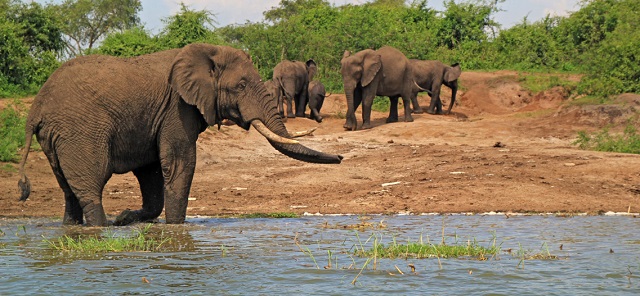
Conservationist body lists them as critically endangered
Kampala, Uganda | RONALD MUSOKE | Conservationists across Africa have welcomed a recent decision to upgrade the African savanna elephant and forest elephant as “endangered” and “critically endangered” species.
The International Union for Conservation of Nature (IUCN), which is the global authority on the status of the natural world, on March 25, announced the upgrade on its Red List of Threatened Species. It said the elephant species face existential threats. It said their populations are declining due to poaching and habitat loss.
The latest IUCN Red List includes 134,425 species, 37,480 of which are threatened with extinction. Over 8,000 species are listed as ‘Critically Endangered’ and over 14,000 as ‘Endangered.’ But it’s the new status of the African elephants that attracted the most attention.
“The new report should attract more attention to forest elephants. Less visible and easily monitored than savanna elephants, they tend to be overlooked by the governments and donors, and their needs are overshadowed by those of their larger cousins,” said Kathleen Gobush, the lead assessor of the African elephants and member of the IUCN species survival commission— the African Elephant Specialist Group.
“We welcome the upgrade and hopefully governments all around the world will take this seriously,” said Bashir Hangi, the communications manager at the Uganda Wildlife Authority.
“Elephants are one of the most highly sought after species by wildlife traffickers and we must also upgrade the level of protection.”
“Treating elephants like any other species puts their survival in danger and unless measures are taken by governments to narrow the space for operation by the traffickers, we will not achieve much,” Hangi told The Independent.
“We support the IUCN decision at this time to update the African forest elephant to critically endangered and the savannah elephant to endangered, and believe it tracks with criteria in accordance with their red-listing process,” Dr. Philip Muruthi, the vice president of the Africa Wildlife Foundation in charge of species conservation and science said.
In order to establish the level of risk, experts at IUCN finally agreed that African elephants are actually two species. The savanna elephant is larger, has curving tusks, and roams the open plains of sub-Saharan Africa while the forest elephant is smaller and darker; has straight tusks and lives in the equatorial forests of Central and West Africa.
Bas Huijbregts, the African species director at the World Wildlife Fund (WWF) said the potential positive conservation impact of splitting forest and savanna elephants into separate species cannot be overstated.
“Challenges to both species are very different, as are the pathways to their recovery,” he said.
The forest elephants’ population has plummeted by 86% in the last 31 years while that of the savanna elephants has dropped by 60% in the last 50 years, according to the IUCN.
The IUCN noted that both species whose current population is estimated at about 415,000 have suffered sharp declines since 2008 due to a significant increase in poaching that peaked in 2011.
The persistent demand for elephant ivory because of its beauty and artistic uses has dramatically reduced the elephant population across the African continent, speeding the loss of a keystone species that plays a critical role in maintaining the biodiversity of natural ecosystems.
The multilateral treaty to protect endangered plants and animals (CITES) banned the international trade of ivory in 1989, but not all countries have adhered to the Convention, and there have been peaks and valleys for ivory sales over the past three decades.
Many Asian and Southeast Asian countries still contribute to the illegal ivory trade. Prior to the global COVID-19 pandemic, an estimated 20,000 African elephants were still being killed each year for their ivory. And the trade routes for African elephant ivory are still largely flowing to dealers in Asia but, in recent years, China has increased its efforts to stop the ivory trade.
“Rebuilding elephant populations requires protecting their habitat as well as continuing to clamp down on poaching and ivory trafficking,” said Scott Schlossberg, a data analyst at Elephants Without Borders, a Botswana-based NGO in an interview with National Geographic, “Allowing new ivory sales could jeopardise the progress that has been made recently in ivory trafficking.”
The IUCN relies on a variety of factors to determine an animal’s conservation status, such as how much its numbers and ranges have dwindled.
Using data dating back to the 1960s for savanna elephants and the 1970s for forest elephants, Gobush and her colleagues built a statistical model to estimate population reductions over time.
What came to light was that savanna elephants have declined by more than 50% over three generations (75%), tipping them into the endangered category.
Meanwhile, the IUCN’s assessment also noted that there have been successful conservation programmes in Gabon and Congo-Brazzaville for the forest elephants andthe Okavango-Zambezi Trans frontier Conservation Area for the savanna species.
Bruno Oberle, the IUCN director general said in a press statement that this proves elephant declines can be reversed. “We must work together to ensure their example can be followed,” he said.
****
 The Independent Uganda: You get the Truth we Pay the Price
The Independent Uganda: You get the Truth we Pay the Price






That’s good, build lots and lots of elephant sanctuaries, giving in order for the elephants to breed more calves as possible, aim to get there population growing again as urgent.
Two of Africa’s elephant species are now re-classifed as endangered species. The African bush elephant is now endangered as the African forest elephant is now critically endangered due to poaching and habitat lost.
Poachers should stop killing more on these beautiful animals and ivory markets and shops should be banned forever.
Elephant huntings for trophies should also be banned.
Humans should not kill these magnificent beasts again, they’ll go extinct otherwise.